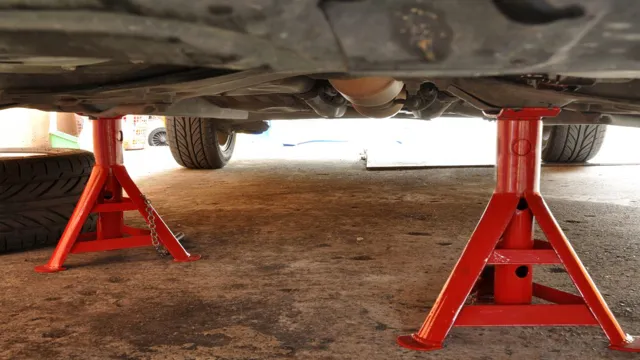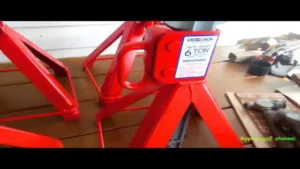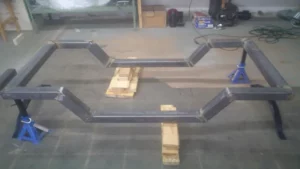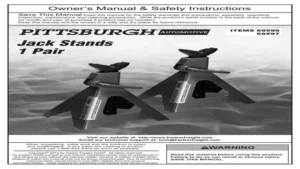Have you ever found yourself in a situation where you need to change a flat tire or do some maintenance work under your car? If you have, then you know that using scissor jacks and jack stands can help you lift your car safely and effectively. But if you are not familiar with how these tools work, it can be a daunting task to figure out how to use them correctly. In this blog post, we’ll share some tips on how to use scissor jacks and jack stands to lift your car safely.
We’ll go over the basics of using scissor jacks and jack stands, step-by-step instructions, and some safety tips to keep in mind. By the end of this post, you’ll be equipped with the knowledge you need to safely lift your car and get the job done. So, let’s get started!
What You’ll Need
If you’re planning to do some work underneath your car or you simply need to change a tire, putting your car on jack stands with a scissor jack is your safest bet. But before you start, you’ll need to make sure you have a few things on hand. The most important item you’ll need is a set of jack stands, which you can purchase at most auto parts stores or even online.
These stands are specifically designed to hold vehicles in place when they are lifted. You’ll also need a scissor jack that can be raised and lowered to lift the car off the ground. This may either come standard with your vehicle or be sold separately.
Finally, you’ll need a level surface to work on and a few other essentials like wheel chocks and work gloves, to ensure a safe and secure operation. Once you’ve gathered all your equipment, you’ll be ready to move your car onto the jack stands safely.
Scissor Jack
If you’re looking to undertake some vehicle maintenance, a scissor jack can be a very handy tool to have. Not only is this type of jack relatively small and easy to store, but it is also easier to use than some other types of jacks. To get started, you’ll need a few things.
First, you’ll obviously need the scissor jack itself. You’ll also need a wrench or spanner to loosen and tighten the lug nuts on your wheels. Depending on the type of scissor jack you have, you may also need a socket and ratchet to operate it.
Finally, you’ll want to make sure you have a wheel chock or some other form of chocking device to prevent the vehicle from rolling while you work. With these tools in hand, you’ll be ready to safely and easily lift and lower your vehicle as needed. Just make sure to follow all safety guidelines and don’t attempt any vehicle maintenance or repairs unless you are properly trained and equipped!
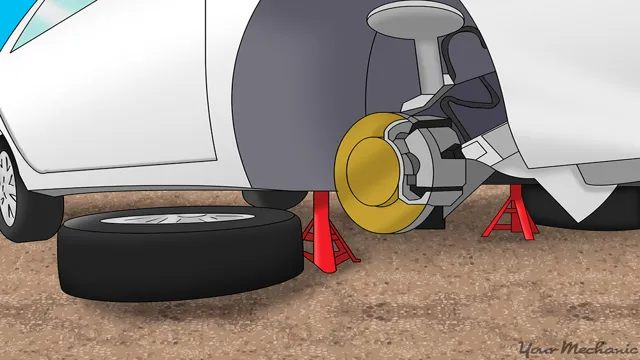
Jack Stands
When it comes to using jack stands, safety should be your top priority. To ensure that your vehicle is well-supported, you’ll need to make sure you have the right equipment on hand. A good set of jack stands is essential, and you’ll want to choose a model that is designed to handle the weight and size of your vehicle.
You’ll also need a sturdy jack that can lift your vehicle off the ground safely, along with a set of wheel chocks to help keep it from rolling away. Don’t forget to wear protective gear like gloves and eye protection, and make sure you’re working on a level surface. By taking these precautions and using the right tools, you can enjoy the peace of mind that comes with knowing you’re working in a safe and secure environment.
Wheel chocks
When it comes to maintaining the safety of your vehicle, wheel chocks are an essential tool to have on hand. These simple devices are designed to prevent your car from rolling away during maintenance or repairs. To use them, you’ll need a few key items.
Firstly, make sure you have a pair of high-quality wheel chocks made from sturdy materials like rubber or plastic. You’ll also need a level and stable surface to park your car on, plus a set of wheel blocks or ramps to help you position the chocks correctly. When using your wheel chocks, always place them snugly against the tire and make sure they’re properly secured.
With these tools on hand, you can enjoy the peace of mind that comes with knowing your vehicle is secure and stable while you work on it. So invest in a good set of wheel chocks today and stay safe on the road!
Gloves and safety glasses
When it comes to DIY projects, safety should always be your top priority. One of the most important measures to take is to wear gloves and safety glasses. Gloves will protect your hands from sharp objects and potential harm from power tools, while safety glasses will shield your eyes from flying debris and dust.
It’s important to note that different projects may require different types of gloves and glasses. For example, leather gloves are great for handling rough materials like wood, while latex gloves are perfect for painting and cleaning. As for safety glasses, you’ll want to choose a pair with side shields and lenses that are impact-resistant.
By investing in the right gloves and safety glasses for your project, you’ll ensure that your DIY endeavors are not only successful, but safe as well.
Step-by-Step Guide
Putting a car on jack stands with a scissor jack can seem like an intimidating task, but with the right steps, it can be done safely and efficiently. The first step is to find a flat and stable surface to work on. Once you have found the right location, use the scissor jack to lift the car up a few inches, making sure the jack is positioned securely under the designated jacking point.
Next, slide the jack stand under the car’s chassis, positioning it just below the jacking point. Slowly lower the car onto the jack stand, making sure it is snugly in place. Repeat these steps on the other side of the car to ensure it is evenly balanced.
Double-check that all four jack stands are secure and level before starting any work on the car. By following these steps, you can safely and easily put your car on jack stands with a scissor jack.
Park Your Car on a Flat Surface and Engage the Parking Brake
When it comes to safely parking your car, it’s important to follow a few simple steps to prevent accidents and damage to your vehicle. The first step is to find a flat surface where you can park your car. If your car is parked on an incline, it can roll away if the parking brake fails or if someone accidentally bumps into it.
Once you’ve found a suitable spot, engage your parking brake. This will help keep your car in place and prevent it from moving. It’s important to engage the parking brake before you shift your car into park or neutral, as this will help distribute the weight of the car more evenly and make it harder to move.
By following these simple steps, you can help keep your car secure and prevent accidents while it’s parked.
Insert the Scissor Jack Underneath the Car and Locate the Jacking Points
When it comes to changing a tire or working under your car, a scissor jack is a vital tool to have in your inventory. However, not everyone knows how to properly use one. The first step is to locate the appropriate jacking points underneath your vehicle.
These points vary depending on your car’s make and model. You can refer to your owner’s manual for detailed instructions on where to place the jack. Once you have located the jacking points, position the scissor jack in the right position under the car.
It’s crucial to ensure that the jack is resting on a solid and flat surface to prevent it from slipping or shifting while lifting the car. After doing so, you can now insert the jack handle and begin cranking the handle until the car starts to lift. Remember to take caution while lifting your vehicle, always double-check and make sure you are using your jack properly and in the right position.
By following these steps, you can safely and confidently use a scissor jack to get work done on your car when you need it.
Use the provided wrench to slowly raise the car until the wheels are off the ground
When it comes to lifting a car off the ground for repairs, safety should always come first. To do this, use the provided wrench to slowly raise the car until the wheels are off the ground. And it’s not just a matter of raising the car as quickly as possible to get the job done.
You don’t want to push the limits of your equipment or risk injury. Instead, take your time and work your way up slowly, just like lifting weights. Start by positioning the wrench and checking everything is stable before you even start to apply pressure.
Remember, safety is always priority number one. When it comes to raising a car, patience and attention to safety will help avoid unnecessary accidents. So take your time, breathe, and follow the proper steps, and you’ll get that car off the ground in no time.
Place Jack Stands Underneath the Car and Lower It Onto the Stands
One important step when working on your car is to make sure it is securely propped up on jack stands. This provides a stable base and prevents the car from falling on you while you work. Here is a step-by-step guide on how to place jack stands underneath your car and lower it onto the stands.
First, park your car on a level surface and engage the emergency brake. Locate the jacking points on your car, which are usually marked with an arrow or a symbol. Use a hydraulic jack to lift the car at these points, making sure it is lifted high enough to comfortably slide the jack stands underneath.
Next, place the jack stands in a secure position under the car, just behind the jacking points. Slowly lower the car onto the stands, checking to ensure that they are at the correct height and properly positioned. Once the car is resting securely on the stands, give it a gentle shake to make sure it is stable.
With the car now safely elevated, you can begin your repairs or maintenance. Remember that safety comes first when working on your car, so always double-check that it is secure before beginning any work.
Double Check Placement of Jack Stands and Ensure They Are Securely in Place
When it comes to car maintenance, safety should always be your top priority. Double-checking the placement of your jack stands and ensuring they are securely in place can save you from serious injury or damage to your vehicle. To begin, make sure you are on a level surface and the emergency brake is engaged.
Lift your vehicle with a hydraulic floor jack and slide the jack stand underneath the proper jacking point. Slowly lower the car onto the jack stand, making sure it is properly aligned and engaged. Repeat this process for all the jack stands needed.
Once the vehicle is securely on the stands, gently shake the car to check for any instability or wobbling. If everything is in order, you are ready to work on your vehicle. Remember, it is always better to take the extra time to ensure your jack stands are properly placed than to risk injury or damage.
So, the next time you work on your car, double-check your jack stands and stay safe!
Lower your car onto jack stands
Lowering your car onto jack stands can be an intimidating task, but with the right tools and guidance, it can be done safely and efficiently. Here’s a step-by-step guide on how to lower your car onto jack stands. First and foremost, find a level surface to work on and ensure your emergency brake is engaged.
Next, use a floor jack to lift the car from the designated jacking point, typically marked in your owner’s manual. Once your car is high enough, slide the jack stands under the car’s designated jacking points. Make sure the jack stands are positioned securely and evenly, then slowly lower the car onto the jack stands.
Finally, give your car a gentle nudge to ensure it’s stable and secure before getting to work. Always remember to follow safety precautions and never work under a car that’s only lifted with a jack. Stay safe and happy wrenching! The main keyword used is “jack stands”.
Test the car for stability before you begin working on it
Before beginning work on your car, it’s important to ensure its stability. This step may seem tedious, but it’s vital for your safety. The last thing you want is for the car to collapse while you’re working on it.
Follow these simple steps to test your car’s stability: First, park on a level surface. This will give you an accurate reading of your car’s stability. Next, press down on each corner of the car.
If your car remains stable and doesn’t bounce, it’s ready for you to work on it. However, if the car bounces or feels unsteady, it’s best to have a professional inspect it before you begin fixing it. Remember, your safety is paramount, and taking a few minutes to test your car’s stability could potentially save your life.
Conclusion
In conclusion, putting a car on jack stands with a scissor jack can seem like a daunting task, but with the proper technique and precautions, it can be done safely and efficiently. Remember to always read the owner’s manual and follow the instructions carefully. And while you’re at it, why not put on some tunes and make it a party? After all, who said car maintenance can’t be fun?”
FAQs
What is the maximum weight limit for scissor jack?
The weight limit for scissor jack varies, but most of them can support up to 1.5 to 2 tons.
Can scissor jack be used on all types of cars?
While scissor jack is compatible with most cars, it is not recommended for heavy-duty vehicles or off-road trucks.
How can I locate proper jacking points for my car?
Check your car owner’s manual for the manufacturer’s recommendations on jacking points. Otherwise, look for a reinforced frame or a solid axle to place the jack.
Is it safe to use scissor jack on sloped surfaces?
No, it is not safe to use scissor jack on sloped or uneven surfaces. Always select a flat and stable surface to park your car and place the jack.
How can I secure my car on jack stands?
Once you lift the car on scissor jack, place jack stands under the jacking points, and slowly lower the car onto them. Then, double-check that the jack stands are secure and balanced on the jacking points.
Can I repair my car on scissor jack alone?
No, it is not recommended to repair your car on scissor jack alone, as it can slip or tilt, causing damage to your car or injury to yourself.
What is the proper way to lower my car from jack stands?
Always start by removing the wheels and the lug nuts, and then slowly lower the car onto the ground by reversing the jacking process, i.e., raising the car slightly with the jack stands and removing them.
